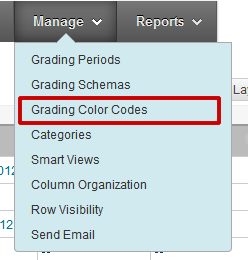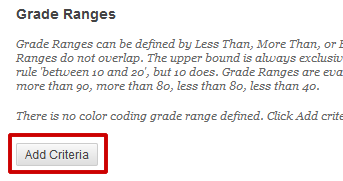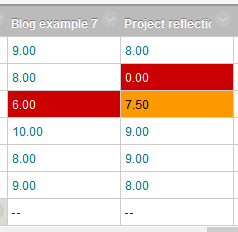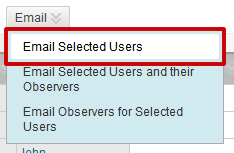Quickly identify and contact students who need help
Combining color-coded cells in the Grade Center table with the Email from Grade Center tool makes it easy to identify and get in touch with students who are having difficulty mastering your course material. Fortunately, it’s also easy to set up these features.
First, let’s look at how we can color code a grade center column to make it easier to quickly identify a student who is slipping.
Open the Grade Center in your course. Point to MANAGE at the top, then choose “Grading Color Codes”.
First, make sure “Enable Grading Color Codes” is selected.
You’ll notice you can change the background color of a cell depending on it’s state (you could set all NEEDS GRADING cells to green, for example). We’re going to set some criteria for coloring cells based on a grade range. Under the GRADE RANGE heading, click the ADD CRITERIA button.
Now we can set up a coloring scheme.
On the Criteria pull down, choose whether you want to color a cell that is between a set of percentages, more than or equal to a percentage, or less than a percentage. For this example we’ll use “LESS THAN”, because we want an alert when students are under-performing.
 In the next box, enter the percentage you want to use. In this case, we want a cell to change color when a student scores less than 80%, so we’ll enter 80 in the percentage box. This means if a student scores 79.9% or less, the cell’s color will be changed. If we had chosen “BETWEEN,” we’d have two percentages — in that case, enter the upper and lower limits.
In the next box, enter the percentage you want to use. In this case, we want a cell to change color when a student scores less than 80%, so we’ll enter 80 in the percentage box. This means if a student scores 79.9% or less, the cell’s color will be changed. If we had chosen “BETWEEN,” we’d have two percentages — in that case, enter the upper and lower limits.
Next, pick the background and foreground colors. The INDICATOR PREVIEW column will show you a sample of what the Grade Center cell is going to look like, so you can make sure you can easily read your color combination.
If you’d like, click ADD CRITERIA again to add a new rule.
NOTE: You can stack “LESS THANS” or “MORE THANS” if you’d rather not use the between option. If you set a coloring rule that has the background color turning to orange at less than 80 percent, and a rule that sets the background to red at 70 percent, then anyone in the 70%-80% range will show up orange and anyone below 70% will be red.
When you’re done, click SUBMIT at the bottom of the page.
Congratulations. Now any one who falls into your color scheme range should have Grade Center cells that show up in your selected colors. In the example below, we see two 10 point columns colored according to the coloring scheme above:
As you can see, it’s easy to tell that these two students are had problems with their blog and reflection assignments. We should send them an email and ask them to schedule a meeting during office hours. Fortunately, we can email directly from the Grade Center.
Just check the names of the students you’d like to email …
Then point to the EMAIL button at the top or bottom of your Grade Center spreadsheet and choose EMAIL SELECTED USERS.
The email users page should be pretty familiar to anyone who has sent email through Blackboard. This particular page includes the option to send a blind copy of your message to an email address that is not one of the students in your course.
This may be helpful for notifying an advisor or University Academic Services at the same time that you contact a student who is having a problem (NOTE: due to the way Blackboard sends email, folks who are blind copied will not know who the message we sent to either, so you may want to identify the student you are emailing in the body of your email).
Type your subject in the subject space and your message in the message space. Because students won’t know whether anyone else in the class is included in your email, a single carefully crafted message can give several students the impression that they are being contacted individually and personally.
Beneath the message space is a checkbox for “Include list of recipients”. If you check this box, the copy of the message which is sent to you will include the names (or, in the case of a BCC address, the email address) of everyone you sent this message. This may be helpful for your records.
When you’re done, click SUBMIT to send your email.
Shortlink for this post: http://ids.commons.udmercy.edu/?p=426










